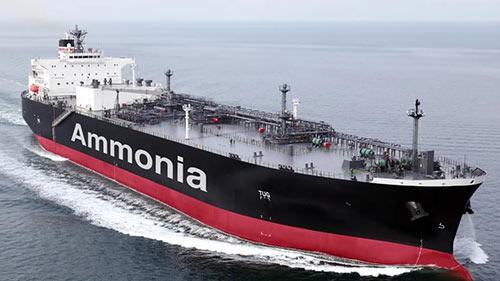Ahead of last November’s 77th session of the International Maritime Organization’s (IMO) Marine Environment Protection Committee (MEPC 77), Japan joined calls to make international shipping carbon neutral by 2050, supporting a proposal by the US, the United Kingdom, Norway and Costa Rica for IMO to raise the bar on its ambition and bring the regulator into line with other bodies pledging net-zero emissions by the midpoint of the century.
Announcing the Japanese government’s policy, transport minister Tetsuo Saito stated: “As Japan aims to become carbon neutral by 2050 it has also set out a carbon neutral target for total greenhouse gas (GHG) emissions from international shipping by 2050 … the Japanese government will also promote the development and demonstration of zero-emission ships such as hydrogen-fuelled ships or ammonia-fuelled ships, which are essential to realise the target.”
The Japanese Shipowners’ Association (JSA) was quick to show its full support of the policy, with its president, Junichiro Ikeda, announcing on the same day: “Today, as a current and future leader in the global shipping field, the Japanese shipping industry has committed itself to the challenge of 2050 net-zero GHG.”
Vessel Development
Ikeda, who is also chairman of Mitsui OSK Lines (MOL), noted that he believed that there were two possible ways to decarbonise: to gradually convert the use of LNG fuel into carbon-neutral methane or expand the research on the use of hydrogen and ammonia fuel. In line with this thinking, Japan has decided to hedge its bets and develop a hydrogen-fuelled ship, commercialise an ammonia-fuelled ship, and develop technology to significantly reduce methane slip in LNG fuel through its ‘Next Generation Vessel Development’ project.
The project, which involves a number of consortia made up of Japanese shipping companies, shipyards, engine manufacturers and trading companies, as well as universities, has selected four themes for research and development: 1) Development of marine hydrogen engine and marine hydrogen fuel system (MHFS); 2) Development of ships equipped with ammonia fuel domestic engines; 3) Integrated project of ammonia fuel ship development and social implementation; and 4) Development of methane slip reduction technology for LNG-fuelled ships by improving catalysts and engines.
Hydrogen
Work on theme 1 is being undertaken by a consortium that includes Kawasaki Heavy Industries (KHI), Yanmar Power Technology (YPT) and Japan Engine Corporation (J-ENG). The partners will simultaneously develop low-speed, medium-speed and high-speed engines using hydrogen as fuel and plan to have a line-up of engines that can be used in a variety of applications ready by 2026.
KHI is to develop a medium-speed four-stroke engine with a propulsion output of between 2,000kW and 3,000kW; YPT a medium-speed and high-speed four-stroke auxiliary equipment engine with an output of 800kW and 1,400kW; and J-ENG a low-speed two-stroke engine for propulsion with an output of 5,000kW.
KHI is to also develop the MHFS, which will consist of a marine hydrogen fuel tank and a fuel supply system. The MHFS will be applied to the demonstration operation of medium and high-speed four-stroke engines, and two-stroke engines, after land-based tests, according to KHI.
Ammonia
Two consortia are working to commercialise ammonia fuel, each with the aim of introducing ammonia-powered vessels by 2028, ahead of other nations. A “demonstration project for the commercialisation of vessels equipped with a domestically produced ammonia-fuelled engine” is headed up by NYK Line, J-ENG, IHI Power Systems and Nihon Shipyard. The project, which got underway in December 2021 and also involves ClassNK, will develop an ammonia-fuelled tugboat (A-Tug) and an ammonia-fuelled ammonia carrier.
For the ammonia carrier, J-ENG will develop a two-stroke ammonia fuel engine of about 8,000kW as the main engine and IHI Power Systems will develop a four-stroke fuel engine of approximately 1,300kW for the auxiliary equipment. NYK Line will be responsible for project management, ship design and legal compliance, while Nihon Shipyard will oversee hull development and examine ship construction methods. Again, ClassNK will carry out a safety assessment of the ship.
The second consortium working on ammonia fuel comprises Kawasaki Kisen Kaisha (K Line), Itochu Corporation, Nihon Shipyard, Mitsui E&S Machinery and NS United Shipping. Their focus is on the development of an ammonia fuel propulsion system and hull, as well as an integrated project covering the establishment of international supply chain for ammonia as marine fuel.
For the full article please see the May 2022 edition of The Naval Architect.




